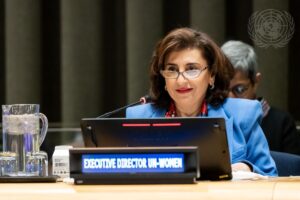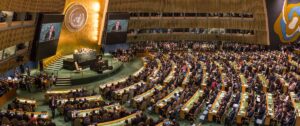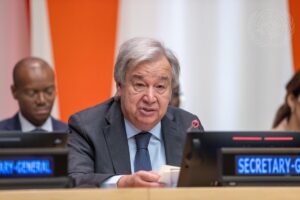Executive Summary
“The COVID-19 pandemic once again reminds us: Global crises require global solutions. We must act together to end the pandemic. And we must not forget those who are affected by extreme poverty and hunger. The UN Sustainable Development Goals are, and will remain, our compass for a better world.”
— Angela Merkel, Chancellor of Germany1Global Citizen, “18 Inspiring Quotes From World Leaders in Support of the ‘Recovery Plan for the World’.”
While the COVID-19 pandemic continues to top lists of pressing global concerns, the catastrophic effects of climate change are felt daily worldwide—from extreme temperatures and droughts ravaging West Asia-North Africa, and rising sea levels affecting many island states and low-lying countries, to ruinous flooding in Europe and China, and wildfires across America’s West and large swathes of Australia. The Intergovernmental Panel on Climate Change predicts that continuation of economic and political business as usual will likely push global warming levels past 1.5°C or 2°C, the aspirational ceilings in the Paris Climate Agreement, to 3-4ºC above 1850-1900 levels by the end of the century, further magnifying already intense droughts, fires, flash floods, and sea level rise.
At the same time, exclusionary nationalism and populism, great power competition, increasing inequalities, and the dark side of cyberspace continue to imperil world order. To effectively contest them while meeting the rising public health and environmental challenges, multilateral cooperation is urgently needed—as stressed in last year’s UN75 Declaration—to harness the ideas, capabilities, and networks of international organizations, governments, businesses, and civil society groups in the interest of effective global problem-solving.
This report focuses on the emerging agenda essential to achieve a global recovery over the next three to five years that is sustainable, equitable, and inclusive. Such a recovery is arguably more complex, costly, and politically fraught than most leaders have as yet been willing to admit. That does not make it any less necessary: a recovery plan that goes beyond pandemic response and combats climate change; in other words, a recovery that is broad-based, as well as green. The recommendations in this report are designed to further those goals. Grouped under the headings of climate action, a fair and inclusive economy, health and well-being, especially of the most vulnerable, and digital connectivity, the report offers twenty related recovery initiatives for ratcheting-up the Paris Climate Agreement’s ambitions and recalibrating the 2030 Agenda for Sustainable Development to address, in particular, those most adversely affected by the virus and its knock-on effects:
Section III: Making the Recovery Green and Sustainable
1. Prioritize a “green” recovery within the COVID-19 recovery plans of governments and regional and global governance bodies, including by taxing carbon and ending fossil fuel subsidies. To support nationally-tailored mitigation (emissions-reducing) and adaptation (resilience-enhancing) strategies, recovery plans need sufficient resources, technical analysis, and political and societal backing.
2. Incentivize the private sector, within appropriate regulatory frameworks and with external assistance, to invest in a circular economy that reduces waste and promotes environmental sustainability. Tax reforms, leveraging public funding, and public-private partnerships can each motivate the business community to invest in a circular economy.
3. Promote more efficient and climate-friendly ways of producing hydrogen for a green recovery through a Global Green Hydrogen Alliance. Priority steps should include setting-up a global inventory of green hydrogen programs, protecting intellectual property and licensing rights while expanding global access, and encouraging alliance-wide standard-setting for safe storage and transportation.
4. Treat the protection of forests as a global collective action problem needing active monitoring and support from both governments and business. Establish a technical monitoring body, combined with a mix of external technical collaboration, information exchange, and political pressure, to aid forest governance worldwide.
5. Enhance the strategic communications capacities of global and regional organizations to broaden understanding of the local impact from global warming and action needed to counter it. Meaning-making, getting climate framing right, and engaging local influential voices are tested strategies for reaching diverse target audiences.
A recovery plan that goes beyond pandemic response and combats climate change; in other words, a recovery that is broad-based, as well as green.
Section IV: Making the Recovery Fair and Inclusive
6. Invest in human capital and upgrading skills to facilitate a broad-based and green recovery, emphasizing support to people at risk. Planning instruments should privilege investments in low carbon activities and infrastructure with rapid job creation potential to support people at risk of unemployment, including youth.
7. Support micro-, small-, and medium-sized businesses to accelerate the private sector transition to more equitable and greener practices. Private sector incentives and public-private knowledge-sharing networks can facilitate the transition away from carbon-intensive industries.
8. Create a standardized corporate tax solution to reshape global commerce and address inequality. Adopt the G7’s July 2021 decision calling for a minimum 15 percent tax rate on global corporations with more than about U.S. $900 million in annual revenues.
9. Establish a coordination mechanism to trade debt for investments in the environment to address the debt, climate, and biodiversity crises. An “organizing framework” for innovative Debt-for-Nature-Swaps can help to create unity of purpose between debt relief and a developing country’s plans for investing in green, resilient, and inclusive development.
10. Fill development financing gaps to create sustainable COVID-19 recovery opportunities, focusing on vulnerable economies. In coordination with the World Bank and International Monetary Fund, regional development banks are well-placed to offer tailored and immediate recovery funding to vulnerable countries in their region.
Section V: Making the Recovery Health- and Well-Being Focused
11. Create a Multisectoral Coordination Mechanism as a tool for governments to operationalize the World Health Organization’s “One Health” guidelines on climate-related threats to public health and human-animal-environmental interdependence. Fully implementing these guidelines will help to track emerging diseases and respond to outbreaks quickly and cost-effectively.
12. Waive intellectual property protections for COVID-19 vaccines and therapeutics through the World Trade Organization as a first step towards greater vaccine availability worldwide. Treat COVID-19 vaccines as global public goods, making them easily accessible and replicable globally.
13. Create a Global Fund for Social Protection to assist developing country governments in providing adequate social protection systems. Such a fund would boost coordination efforts, mobilize domestic and external resources, and buffer against economic shocks.
14. Create a public-private Global Food Systems Innovation Alliance to fight famine and food insecurity and improve food affordability, safety, and sustainability. Such systems can bring together key public and private sector stakeholders, as well as international organizations and civil society.
15. Scale up financing for water infrastructure projects to ensure safe water and sanitation for all. An estimated U.S. $114 billion is needed annually to meet water, sanitation, and hygiene commitments worldwide. Blended financing mechanisms could pool public and private resources and reduce the risks associated with large-scale water infrastructure projects.
Section VI: Making the Recovery Digital Everywhere
16. Adopt a New Global Digital Deal to expedite the achievement of Sustainable Development Goal 9 on resilient infrastructure, inclusive and sustainable industrialization, and innovation. The initiative would foster modern and resilient digital infrastructure, particularly in the Global South.
17. Promote large-scale investment in Information and Communications Technology infrastructure to achieve digital equity. International organizations and governments should partner with businesses to ensure effective and reliable digital connectivity, including through targeted investments in the steady digitalization of most (if not all) public services.
18. Fund digital outreach and skills training to combat mis-/disinformation and foster a digitally literate global citizenry. Greater digital literacy can help users leverage these technologies’ economic, health, and environmental potential.
19. Protect indigenous communities and Small Island Developing States through tailored improvements in digital connectivity. ICT hubs and increased online access can give indigenous and island communities the help needed to forge and implement community post-pandemic recovery plans.
20. Incentivize greener digital technologies and e-commerce via global carbon taxes, agreements governing digital trade, and laws curbing “flash” sales. Such taxes can motivate tech firms to decarbonize, and tax revenues can be used to fund better electronic waste management and recycling programs.
A number of significant international meetings will take place over the next ten months, which allow the international community to take significant steps toward a shared recovery. However, actually marshalling governments, businesses, and global civil society behind a coherent, representative, and sustained global implementation strategy will require a culminating session—a “Green Pandemic Recovery Summit.” Orchestrated by the United Nations and G20, and timed to coincide, in September 2022, with the annual UN General Assembly High-Level Week, the proposed two-day summit would help to ensure that political leaders at the highest levels commit to advancing, by all creative means at their disposal, a common approach to climate-forward and equitable socioeconomic development post-COVID-19. Steps to ensure its success would include:
- Establishing a small summit secretariat and building upon existing planning frameworks: It should welcome secondments from the UN, World Bank, IMF, WTO, and G20 Presidency to the organizing team, and integrate these institutions’ planning instruments into summit preparations.
- Encouraging citizens’ voices, especially women and youth, through global-regional civil society forums and online platforms: These in-person and virtual discussions could facilitate non-governmental advocacy, research, and business-oriented groups to provide a watchdog role and weigh-in on the kinds of green recovery policy prescriptions world leaders need to hear.
- Convening a High-Level Meeting on Green Pandemic Recovery Financing, in conjunction with April 2022 World Bank-IMF Meetings: This could shine a light on mobilizing domestic revenue, combating illicit financial flows, and public-private (or blended) financing gaps, including serious funding shortfalls for the Sustainable Development Goals.
- Ensuring that the proposed summit results in a focused and action-oriented agenda for a just, health-focused, and sustainable global recovery: It should encompass both programmatic initiatives and structural economic reforms that are carefully prioritized, sequenced, budgeted, and measurable. And it should bring the G20 as a forum into more regular interaction with the UN system, creating a relationship we call the “G20+.”
The trillions of dollars in COVID-19 stimulus spent in the richest countries confirm that financial tools are available for serious issues when political will is mustered and creative market incentives are introduced. What is most needed now are the practical operational details of a durable, environmentally sensitive, and equitable socioeconomic path forward, worldwide, with clear goals, timelines, and creative programming ideas (such as the twenty presented in this report). Commitments and resources drawn from related initiatives can also help, building on the 2030 Agenda for Sustainable Development, the Build Back Better World partnership, the Belt-and-Road Initiative, and the wealth of green deals and programs underway around the world.
People and nations are understandably reeling from the present pandemic, the fear that humanity may be nearing the point of no return with respect to catastrophic climate change, and other global threats looming on the horizon. Fortunately, we already possess a system of multilateral institutions, beginning with the United Nations, designed to nurture and help steer, even if imperfectly, a worldwide political consensus toward a mutual, far-reaching action agenda to better cope with the current crises. Time to get to work.
Actually, marshalling governments, businesses, and global civil society behind a coherent, representative, and sustained global implementation strategy will require a culminating session—a “Green Pandemic Recovery Summit.”
Notes
- 1




